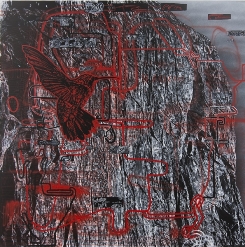* Postmodernism is a philosophical movement away from the viewpoint of modernism.
* Postmodernism is used in philosophy, literature, social sciences and architecture.
*postmodern thinkers may have differentopinions, and people from different fields may have somewhat different definitions of "postmodernism".
* "Postmodern" is of course composed by two parts "post" and "modern".
* The term "postmodernism" comes from its critique of the "modernist" scientific mentality of objectivity and progress associated with the Enlightenment.
* These movements and postmodernism, are understood as cultural projects or as a set of perspectives.
* "Post" is latin for "after", and "modernism" refers to the modern period.
* The term postmodernism is used in a confusing variety of ways. For some it means anti-modern; for others it means the revision of modernist premoses.
2. Use a quote by Witcombe (2000) to define the Post-Modern artist.
Quote:
The post-modern artist is "reflexive" in that he/she is self-aware and consciously involved in a process of thinking about him/herself and society in a deconstructive manner, "demasking" pretrnsions, becoming aware of his/her culture self in history, and accelerating the process of self-consciousness. Deconstructive postmodernism seeks to overcome the ........intellectual constructions.
3. Use the grid on pages 42 and 43 to summarize the list of the features of Post-
Modernity.
Summarize the list: Social and cultural pluralism/disunity/national/ethnic unity.
Attention to play of surfaces, images
Culture adapting to simulation, visual media becoming undifferentiated
Hyper-reality, image saturation
Disruption of the dominance of high culture by popular culture.
Art as process, performance, production, intertextuality
Play, irony, challenge to official seriousness
4/5. Use this summary to answer the next two questions.
Research Chinese artist Ai Weiwei's 'Han Dynasty Urn with Coca-Cola logo'(1994)
in order to say what features of the work are Post-Modern.
Research Chinese artist Ai Weiwei's 'Han Dynasty Urn with Coca-Cola logo'(1994)
in order to say what features of the work are Post-Modern.
Ai Weiwei (born 18 May 1957) is a Chinese artist and political activist, who is also active in architecture, curating, photography, film, and social and cultural criticism. The work he did above was a coca-cola logo and relate to the features of summize the work are Post-Modern because Postmodernism is a philosophical movement away from the viewpoint of modernism. We can see Ai Weiwei's work involved this idea and created a special artwork.
6. Research British artist Banksy's street art, and analyze the following two works by the artist todiscuss how each work can be defined at Post-Modern.
Banksy is a pseudonymous England-based graffiti artist, political activist, film director and painter. His satirical street art and subversive epigrams combine irreverent dark humour with graffiti done in a distinctive stencilling technique. Such artistic works of political and social commentary have been featured on streets, walls, and bridges of cities throughout the world. Banksy's work was born out of the Bristol underground scene which involved collaborations between artists and musicians. Same like Ai Weiwei's work they both postmodern artwork and made viewers enjoyed a lot with these visual arts.










